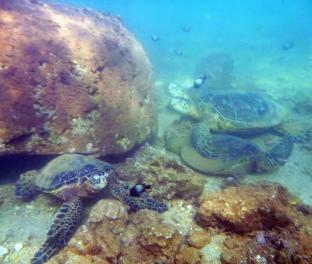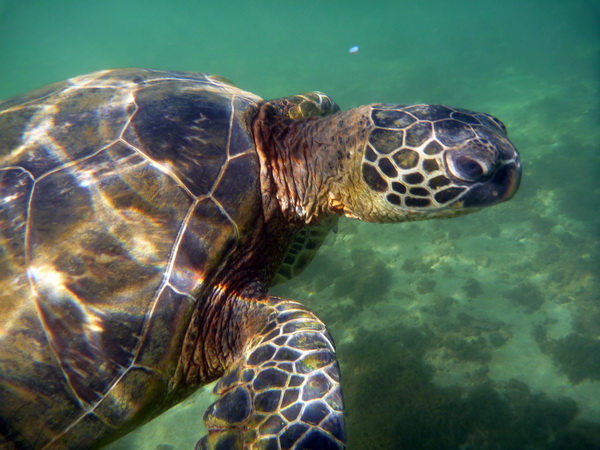Published in the Ocean Watch column, Honolulu Star-Advertiser © Susan Scott
August 22, 2011
Last weekend I swam to my favorite underwater massage parlor, where I counted nine turtles, a record there for me.
The center of this salon is a coral head about the size of my VW beetle that provides shelter for schools of damselfish. The rock also has an ideal overhang for turtles to tuck under and snooze.
 Susan Scott
Susan Scott
Four turtles at a “cleaning station,” where damselfishpick their
shells clean of algae and parasites. The three turtles on
the right are neatly stacked up, waiting their turns.
Turtles congregate at this spot regularly because the damselfish there graze on the turtles’ shells, necks and fins. This is win-win-win: The fish get a meal, the turtles get rid of algae and parasites, and I get to watch a marvel of nature.
I call this spot a massage parlor because it looks like the cleaning feels good to the turtles. As the fish graze, the turtles hang motionless, flippers down, eyelids half shut. One of these super-relaxed turtles even drifted into my leg.
The touch startled me far more than it did the turtle, which swam a few feet away and resumed its passive pose. In seconds the fish were back on the job.
The common sightings of turtles in Hawaii’s waters these days is visual evidence that turtle conservation efforts are paying off, and recent numbers prove it.

‘Iolani School student David Clarke recently presented his project, “Green Sea Turtles Up and Down the Anahulu River,” at the April 2011 International Sea Turtle Symposium in San Diego.
For his project, David and his helpers counted turtles at the mouth of Haleiwa’s Anahulu River on nine evenings and two mornings.
The result was so extraordinary I enlarged the number on my computer screen to make sure I read it right. On his well-done presentation poster, David reported that in 22 hours workers counted 968 turtles swimming up or down the river.
The number likely represents some turtles being counted more than once. Even so, such coming and going is remarkable.
David and his co-authors, federal biologists George Balazs and Stacy Hargrove, report that with the exception of East Island in French Frigate Shoals Atoll, this might be one of the densest concentrations of green turtles in all of the Hawaiian Islands.
East Island in Hawaii’s protected northwest chain is the main nesting site of Hawaii’s green turtles. Regarding that island, a recent email from Balazs brightened my day, as it will that of all turtle admirers.
Balazs wrote that this is the 39th year that he and workers have counted turtle nests at East Island. The first year, 1973, they counted 67 nests. The highest count had been 589 nests in 2008. A month ago, on July 24, workers counted more than 800.
“Please feel some joy (as I am feeling),” Balazs wrote. “Good news can and does occur in the sea turtle conservation world.”
I do feel joy at these encouraging numbers, as well as the fact that I can swim 50 feet off an Oahu beach at any time and visit turtles that aren’t afraid of me. In that, the turtles themselves tell the good news.